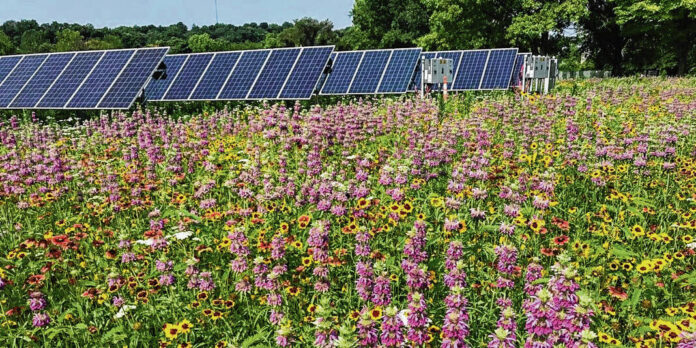
A pollinator-friendly solar installation at the University of Dayton is similar to what developers say is planned at the proposed Swallowtail Solar Farm in northeast Bartholomew County.
Two companies seeking to install a solar farm in Bartholomew County say the project will create jobs during construction and add $38 million to the local economy.
Arevon Energy Inc. of Scottsdale, Arizona and Teneska, an Omaha, Nebraska energy company, are working jointly to created a potential 200-MW Commercial Solar Energy System (CSES) in northern Bartholomew County.
They released an economic analysis for what they are calling Swallowtail Solar Farm, as the Bartholomew County Plan Commission prepares to hear public testimony at 8:30 a.m. Wednesday at Columbus City Hall on proposed regulations of commercial solar energy systems.
The project would create 340 jobs during construction and add $38 million to Bartholomew County’s economy, the analysis states. Throughout the solar farm’s 30-year life, the project will have five direct employees and create 13 indirect jobs, adding approximately $1 million to the local economy, the study claims. It also states that over the 30-year lifespan of the project, Swallowtail is forecast to deliver more than $40 million in local tax revenues to Bartholomew County.
The statistics are contained in an analysis led by Dr. Kenneth Richards, a professor at Indiana University’s O’Neill School of Public and Environmental Affairs.
The economic study released by the Bloomington-based Gnarly Tree Sustainability Institute also modeled the impact of a smaller, 150-MW solar project. A smaller-scale solar farm would produce more than 250 full-time jobs, with compensation topping $22 million during construction, as well as contributing more than $28 million in gross domestic product to Bartholomew County, the analysis said. The study also maintains the smaller project would create 14 full-time jobs and over $830,000 in compensation, contributing about $1.4 million to the local economy.
Local landowners involved in the project will collectively receive millions of dollars in lease payments throughout the solar farm’s lifespan, but still own their property when the life of the project expires, the analysis states.
Beyond job creation and tax revenue, Swallowtail Solar Farm is also set to host Bartholomew County’s largest pollinator garden. Pollinator-friendly plants create important habitat for birds, bees, butterflies, as well as help prevent erosion, improve drainage and enhance soil quality.
The commercial solar energy facility is proposed to be located somewhere between County Road 450N to the north – State Road 9 to the east – East 25th Street to the south and County Road 425E to the west, according to GPS coordinates. A corporate news release states the project would not start construction before the second half of 2024, pending all applicable approvals.
The project will need to complete its field studies and surveys, finalize design, obtain permits, and other steps before it can begin construction. Once a site is chose, a request to construct a solar field must have a public hearing while a conditional use variance is requested from the Bartholomew County Board of Zoning Appeals, according to the developers.
Wednesday’s public hearing will mark the first time that advocates and opponents will be allowed to express their thoughts to county government officials during a public hearing.
If the plan commission approves the recommendations, the regulations will be sent to the Bartholomew County commissioners, who have the final vote on a local solar ordinance regarding design and operation.
For the past two years, the county commissioners have joined with a majority of Indiana counties to oppose state lawmakers attempting to establish rules and regulations for solar and wind companies. Efforts to create standardized commercial solar energy regulations for all 92 Indiana counties have failed.
But earlier this year, state lawmakers approved Senate Bill 411, which allows communities to voluntarily adopt regulations that will qualify them as a wind- or solar-ready community, with the hope that these standards will significantly cut project development time, lower costs and create thousands of jobs in the clean energy industries.
The three commissioners have refused to talk with solar panel manufacturers at this time, and also said they will not consider a temporary moratorium on solar power installations as some have requested.
Their goal is to maintain local control of siting solar fields in order to protect the county’s right-of-ways along local roads, commissioners Chairman Carl Lienhoop said.
“We also wanted to provide a buffer for the people for the people who are going to be living next to these solar farms,” Lienhoop said. “We thought it would be better if we came up with a distance, rather than counting on the state to do it.”
Some of the key proposed regulations to be discussed Wednesday are:
- All structures, equipment, storage areas and fencing, along with the solar panels, to be set back a minimum of 50 feet from the actual or planned right-of-way next to the nearest street or road.
- For rear yard setbacks, the distance must be a minimum of 30 feet from all side and rear property lines.
- No CSES facility shall be located closer than half-a-mile to any municipal boundary line.
- No electrical substation for a solar farm will be located within 750 feet of residential properties, while the minimum distance for related components shall be within 500 feet.
Opponents worry the development of solar projects might hurt neighboring property values, contaminate farmland if panels are damaged, lower the amount of oxygen provided by conventional crops and create a disposal problem when solar panels outlive their usefulness. Advocates deny all of those claims.
Nonprofit group Bartholomew County Citizens Concerned about Commercial Solar Fields (B4CSF) say they are advocates of clean power like wind and solar, but also believe solar arrays should be confined to areas such as brownfields and land adjacent to industrial parks, rather than farmland.
Panel manufacturers suggest the land should be flat and cleared with minimal wetlands and within close proximity to three-phase power and a transmission substation.




